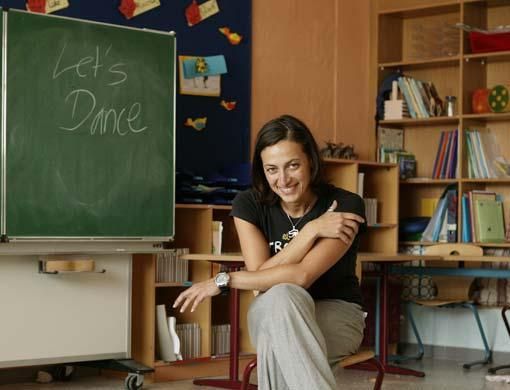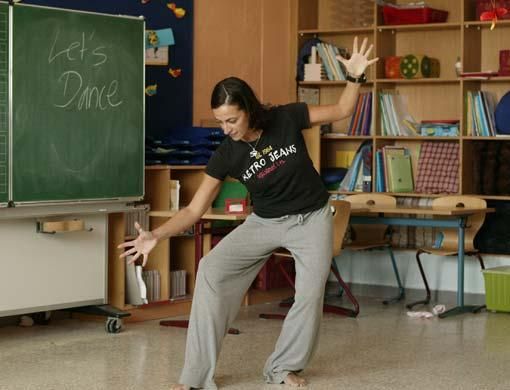She was born with inverted feet and at 3 advised to take dancing lessons to alleviate her walking difficulties. Nadja Issa tells Vibhuti Arora how she overcame her disability
to make a career - in dance
Seeing her brise and buck, minuet and pirouette with finesse few would believe that Nadja Issa was born with inverted feet.
A professional dancer, choreographer and dance teacher, among several other things, Nadja Issa performs precise movements and executes breathtaking acrobatic dance steps that are a dream to behold and which leave a spectator simply slackjawed.
I just love dancing, says the half-Egyptian half-Austrian lady who has made Dubai her home because she is keen to "experience life in a city that is ever growing''.
An effervescent multi-faceted artist who describes herself as "restless and always on the lookout for new challenges'', Dubai seems to suit her just fine.
Her thirst for exploring all areas of her craft is the reason she has explored different aspects of the performing arts - from directing and acting in stage shows to performing in TV shows (mainly German) and in cinema as well as live shows and music videos.
Issa recently finished working on a movie in Germany for which she choreographed and coached German celebrities.
A frequent traveller, she enjoys taking off to Spain, Turkey and Tunisia to create musicals for tourists in vacation resorts, a job she finds "interesting and stimulating''.
Her latest passion is Art in the Air - an innovative form of art and performance providing an array of opportunities for dancers to interact with their surroundings at a totally different level.
Art in the Air can be performed in various locations and venues - from walls of buildings to cranes and theatres, cinemas and sports clubs to shopping malls and fire escapes, she says.
This art form can transform almost any venue into a vertical stage where through a fascinating display of airborne artistry, performers enact a story through dance.
"Art in the Air,'' says Issa, "offers exhilarating aerial dance performances that combine various forms of dance such as stilt dance and flight acrobatics with music to provide alluring, dramatic and compelling performances.''
It is performed on a vertical stage and the audience is transported into a realm of musical experience of entertainment with a difference, she says.
"The challenge of this new form of art is to keep dance interesting,'' says Issa.
"Creating and developing Art in the Air production is strenuous because it is on a totally different level. It is more than just dancing because it takes into consideration different elements such as the venue and its height in relation to the ground in addition to the regular ones such as performance and choreography.''
The choreography itself is quite energetic with performers executing dance movements high above the ground.
"I'm happy with the response this art form is receiving,'' she says.
"Because it's a new form of entertainment, the production is popular and that means more venues and new challenges to tackle. Creating Art in the Air and seeing it evolve gives me a sense of pride and satisfaction."
Being a dancer as well as choreographer Issa has successfully straddled both sides of the fence and she equally enjoys both roles. "It's difficult for me to separate the two. They are intertwined - without one you can't have the other.
"Dancing is second nature to me. I think it's easy to dance and all professional dancers would agree because this is their work and they love it. If they didn't they wouldn't have taken up a career in this field. But it differs for non-professional performers who can be roughly classified under three categories.
"The first group comprises those who love to dance, enjoy it and are quick to learn. These are easy to work with because all you have to do is mould their interest and dance techniques.
"Then there are those who are willing to learn - they are not necessarily terrible dancers but are not the best either. This second group requires patience (in teaching) more than anything else.
"The last group is the not so enthusiastic. They ... are the hardest to work with because (the dance teacher) has to look at different motivational techniques to encourage them to participate," she says.
The turning point
A major turning point in Issa's career came 14 years ago in Frankfurt when at 23 she was selected and sponsored to create a dance theatre company in the city. She was teaching at that time and had to get her students ready for the troupe. With growing community interest in the programme it became the talk of the town.
"As it got hugely popular people's expectations rose as well,'' she recalls. "Although the pressure was high because of all the hype built around the event I managed to turn in a wonderful performance.''
This event boosted her confidence and she never looked back. Last year she got an opportunity to participate in a major show: she choreographed a dance sequence for the opening of the biggest soccer arena built for the World Soccer Championship in 2006 in Germany, the Allianz Arena in Munich.
"With a dance troupe of 350 and an audience of over 65,000 in the stadium and a lot more watching on TV that was an amazing and certainly overwhelming experience," Issa says.
As a performer, she was a member of the Argentinian Flight Acrobatics Company "De La Guarda". It was while working with this group that a new dimension to her idea of choreography took shape - the vertical performance.
With aerial acrobatic and dance routines, this experience expanded her realm of the art of dancing.
Performing after four weeks of gruelling exercise that comprised eight hours of rehearsals, and doing dance movements while suspended in mid air, "I felt like a bird flying above the audience'', she says.
"I also had the pleasure of coaching my favourite star Limahl for a German TV show The Comeback Show. At the age of 14, I was a big fan of the singer and his hit song The Neverending Story, was the soundtrack for a famous movie."
Issa says it's always exciting to work on big projects because there are so many elements involved.
"It's not just about the dance and the performance but the costumes, make-up, preparation, choreography and all the nitty-gritty. The challenge of developing themes and seeing them come to life can be overwhelming. For me that's the most exciting part - translating a concept into a reality.
"Rehearsals are usually fun: performers, stage producers, technical team, people are everywhere. I'm usually loud during the rehearsals.
"But it can be nerve wracking because there are times when the production is multi-faceted which means the coordination has to be precise. Each performer is on clockwork, each second is significant, there's very little room to mess around ...
"As a choreographer I need to visualise the end product with the audience in mind otherwise they might not relate to the performance. When the pieces come together to produce a master performance that enthralls the audience that's when the satisfaction sets in.
"Of course during the show, precision is the key, so all concentration is plugged into this. Everyone is on the edge as the production unfolds but once you hear the thunder of cheering and clapping you know you've achieved your goal. It's very rewarding!''
Experimenting with different dance forms
While creativity fuels her ambition Issa thrives on challenges. Life has never been a smooth ride and Issa admits it would be boring to have it that way.
She says, "I'm always on the lookout for activities to keep me busy. I'm constantly taking on new challenges that push me to new limits. I'm also curious to try techniques that improve my artistry so I'm always experimenting."
Trained formally in ballet, jazz, modern and tap dances, contact improvisation and partnering, Issa developed an interest in experimenting with stilts - an interest which evolved into stilt dancing.
"Now I continue to look at different forms of movements, objects and even locations to add to my art and performance. Of course, the new dimension of aerial dancing and flight acrobatics has also changed my perception that dancing need not be on the ground."
Her favourite however, remains tap dance "because you are your own instrument. It (tap dance) allows you to create your own rhythm while dancing as well as simultaneously being playful to express your rhythm and movements. I like modern jazz as well because it offers a stage of emotional portrayal while dancing," she says.
According to Issa, whose style is modern fusion, the rules of dance as a form of art have changed and dancers are mixing various styles to create their own form of expression. This gives variety to both the entertainer and the entertained and allows room for creativity and style techniques.
Prerequisites of a dancer
It goes without saying that you have to love the art of dancing to master it. "As a dancer you should be willing to try new forms and styles of dancing, because this is where development comes from. It also means that you can create your own style and dance technique that will set you apart from other dancers.
"It's also important to be able to grasp choreographies quickly again; this will bring in opportunities for various choreographers to work with you. Being a team player is a must-have quality in a dancer.
"As a choreographer you need to be able to work with dancers and be open to new ideas and styles. Each dancer can contribute new abilities, trends, styles or even concepts so a choreographer should be open-minded."













